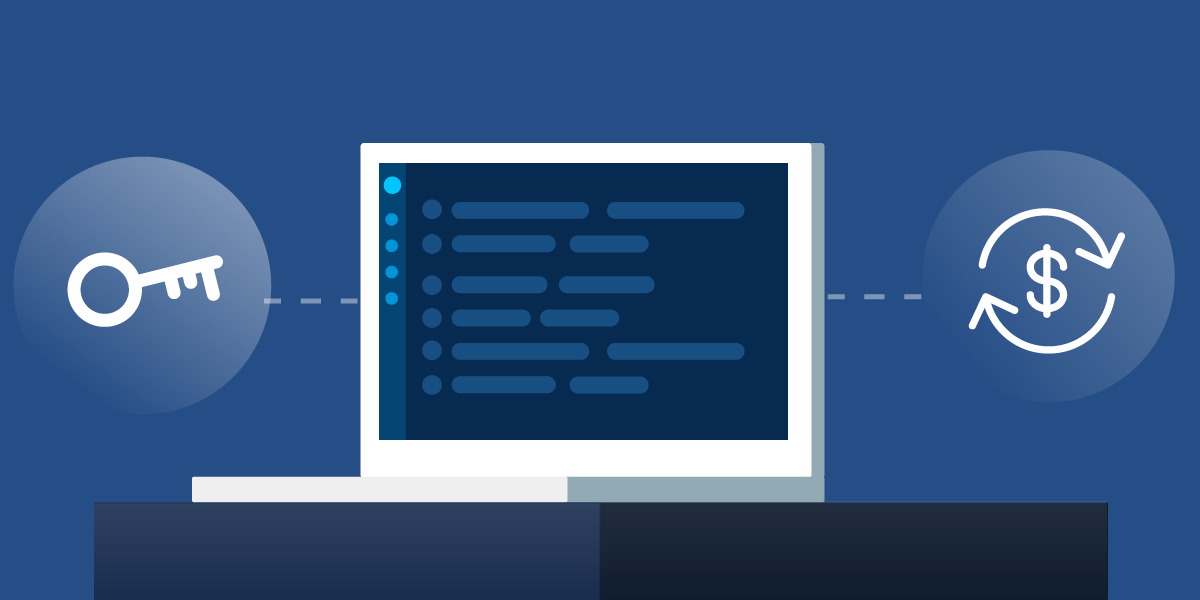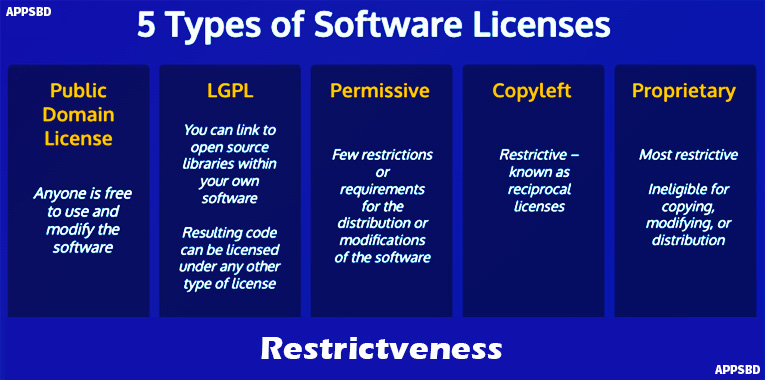
5 Types of Software Licenses – You Should Need to Know About it, Find the Best way to Protect your Software.
Written by Appsbd Blog. Posted in Elite Licenser No Comments
Software License, Every business uses software package to manage business processes, communicate with employees, customers, and vendors, and for myriad alternative functions. In most instances, software merchandise need activating licenses or agreeing to “terms and conditions” before programs are often downloaded, installed, or accessed.
There are many varieties of software licenses, with different terms, support agreements, restrictions, and costs. Users got to perceive the fundamentals of software licenses, to ensure a full understanding of responsibilities and compliance with legal terms and limitations.
What is a Software License?
A software license may be a contract between the entity that created associate degreed provided an application, underlying source code, or connected product and its user. The license is a text document designed to guard the intellectual property of the software developer and to limit any claims against them which will arise from its use.
A software license additionally provides lawfully binding definitions for the distribution and use of the software package. End-user rights, like installation, warranties, and liabilities, also are usually spelled get into the software license, together with protection of the developer’s intellectual property.
Most software falls beneath one amongst 2 classes that have distinct variations in however they’re viewed under copyright law:
- Proprietary – also referred to as “closed source”
- Free and open-source software (FOSS) – referred to as “open source”
FOSS software licenses – give rights to the client that embrace modification and reuse of the software code, providing the actual source code with the software product(s). This open-source variety of licensing affords the user authority to switch the software functions and freedom to examine the software code.
Proprietary software licenses – provide no such authority for code modification or recycle and commonly provide software with operational code only, and no source code. A proprietary software license usually includes terms that forbid “reverse engineering” of the object code with the intention of getting source code by the licencee.
In both cases, the software license can most frequently specify limitations of liability from use of the product, any mutual responsibilities like support, and any warranties or disclaimer of warranty.
Where software isn’t coated by any license, it’s commonly classified as:
- Public domain software – freely obtainable to be used and not copyright protected
- Private unlicensed software – such as business applications that still falls underneath copyright protection
- Transfer of ownership to the customer or retention of ownership by the vendor
- Any authorization for copying, selling, or distributing the
software system - Definition of whether or not the license constitutes purchase or leasing of the software
How Does Software Licensing Work?
New clients of a software will typically go into an end-user license arrangement (EULA) that comprises a legitimate meaning of the connection between the licensor (supplier) and licensee (user or business). The EULA is an agreement that builds up the privileges of the buyer for introducing and utilizing the software.
Each EULA contains a proviso that specifies when its conditions are initiated by an end client. This might be the second the client opens the product packaging or, for instance, when the user tapson a button agreeing to accept the EULA’s terms to access it.
Cloud-based applications like Software as a Service (SaaS) will frequently incorporate license subtleties in EULAs including:
- Monthly or annual charges per user
- Duration of the agreement
- Terms of cancellation of the agreement
- Recovery of any charges if canceled during the agreement
An additional use of software licensing is in situations where a software engineer or firm awards expert for selling or conveying the software under the subsequent party’s image. The developer retains ownership, however the re-marking organization is allowed to resell the software product. This method of licensing is called “white labeling.”
What Are the Types of Software Licenses?
There are five main software license categories or types used to cover different kinds of software and various business arrangements. These encompass a wide spectrum of licensing scenarios, from free software (public domain) to paid commercial software (proprietary).
Between these two extremes, there are also three categories (GNU/LGPL, permissive, and copyleft) that apply to various forms of open-source projects. Failure to follow the terms and conditions of an open-source license can lead to revealing trade secrets or even legal action from the project’s developers.
Types of Software Licenses You Need to Know About

1. Public Domain License
At the point when software is characterized as being in the public domain, anybody is allowed to utilize and change the software without limitations. This is a “tolerant” license that permits receiving the code into applications or projects and reusing the software as wanted.
For some reasons, organizations should practice alert while receiving public domain software in projects or other significant applications:
- Public domain software may not generally stick to best coding rehearses or may not be up to norms of secure software that the application requires.
- Software that doesn’t fall under explicit authorizing terms isn’t generally public domain code. Be certain the software is really public domain prior to replicating, reusing, or conveying it.
2. GNU/LGPL – GNU Lesser General Public License (LGPL)
Under a LGPL license, developers have rights to connection to open source libraries inside their own software. Coming about code can be licensed under some other kind of license – even restrictive – when projects are aggregated or connected to incorporate a LGPL-licensed library.
The admonition is that if any piece of the library is replicated into the code or adjusted, the conditions of the first LGPL license will apply to the created code that utilized the library.
3. Permissive
This kind of license is perhaps the most well-known and famous among open-source software licenses. Under a lenient license – additionally alluded to as “Apache” or “BSD style” – there are few restrictions or requirements for the distribution or modifications of the software. Another variety of a lenient software license is the “MIT” license.
Variations in tolerant licenses remember contrasts for prerequisites for saving license notices and copyrights for the software, just as how the software might be utilized (commercial or private), brand name requirements, and different specifications.
4. Copyleft
This present license’s terms are prohibitive – known as equal licenses. Under the particulars of a copyleft license, the licensed code might be adjusted or dispersed as a feature of a software project if the new code is conveyed under a similar software license.
This means that if the code included in the software product was specified to be for “personal use only,” the new product being distributed must carry that same designation/restriction.
Since the first software included with the new task permitted alterations and circulation, this may not be the best license for software engineers in light of the fact that the subsequent code should likewise convey the copyleft license type – including the accessibility of the source code.
5. Proprietary
These software licenses make the software ineligible for copying, modifying, or distribution. This is the most prohibitive kind of software license, shielding the developer or proprietor from unapproved utilization of the software.
What Is a Software License Agreement?
A software license agreement is a legal document that stipulates several key conditions between a software company or developer and a user to allow use of the software.
These conditions are intended to ensure the designer’s licensed innovation rights and to restrict claims against them for potential harm coming about because of utilization of their software. Now and again, estimating and terms of installment may likewise be incorporated, however this is regularly shrouded in a different archive. The main role of the understanding, in any case, is to give itemized standard procedures to utilization of the software:
- Any copyrights that apply to the software.
- Ownership of the software—most often specifying that the provider retains all rights of ownership.
- Duration of the terms of the agreement.
- What constitutes correct usage of the software.
- Where the software may be installed and how many instances may be installed.
- How the software can be used.
- Whether the software may be copied, modified, or redistributed.
What Are Software Licenses Used for?
Developers release software for variety of reasons, whether or not it’s to demonstrate a new plan, offer profit to as many people as possible, or for money and economic gain. in order to make sure that every one parties concerned within the method are able to enjoy the code, the terms and conditions for its use should be clearly outlined.
These terms and conditions are expressed as a licensing agreement. software licenses are vital for software suppliers and users alike for several reasons:
- Written authority for use of software – protects business users and individuals from liability and copyright infringement claims
- Clarification of the number of eligible users of the software
- Definition of what is included – maintenance, upgrades, support
- Warranty agreements and problem mediation process
- Distribution permission and limitations
- Use rights, such as copying or modifications
- Dates – for installation, training, support assistance, and license duration
- Termination terms, penalties, financial liabilities
- Any performance guarantees and remedies
- Copyright definition, including software and any documentation
Software licenses define the complete agreement between the licensor and retail merchant. The goal is to clarify the connection from each a legal and technical viewpoint, thus there are not any surprises or guessing relating to responsibilities whereas the agreement is in impact.
For mobile software, the license terms state what proportion of the user’s sensitive personal information keep on the device vendor application vender is allowable to access. These agreements are designed to protect personal data like financial statements, location, or health information and stop its misuse.
Software License Management
Managing software licenses and software agreements can be simplified by implementing a management tool that keeps track of all licenses, effective dates, and compliance issues.
Elite Licenser – A very effective, Authentic, User friendly and reliable license managment plugin software for wordpress.
Elite Licenser allows businesses to effectively track open-source licenses across projects, regardless of the type of licenses in use.allows businesses to effectively track open-source licenses across projects, regardless of the type of licenses in use.

